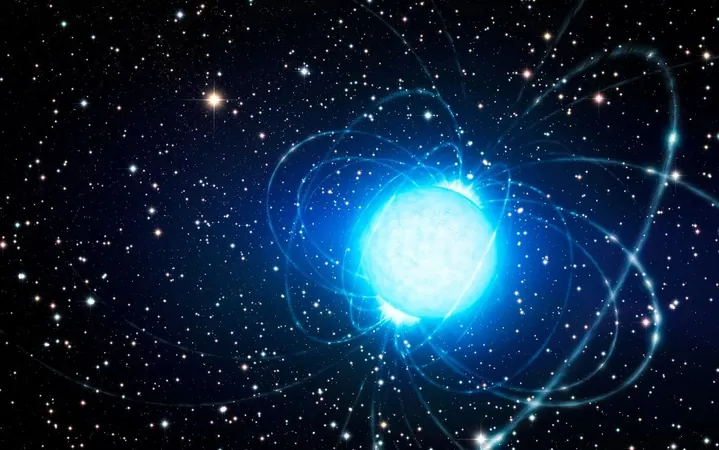
Unraveling the Mystery: How Gravitational Waves Could Illuminate the Secrets of Fast Radio Bursts
2025-01-14
Author: Sarah
Introduction
Fast radio bursts (FRBs) are one of the most enigmatic phenomena in astrophysics. These intense pulses of radio energy can last from mere milliseconds to nearly three seconds, and while the majority originate from outside our galaxy, one has been traced back to our own Milky Way. The mystery deepens with the fact that while many FRBs are seemingly sporadic, some repeat, hinting at deeper astrophysical processes at play.
The Enigma of FRBs
Despite the consensus among astrophysicists that a high-energy astrophysical process is likely behind these bursts, the exact mechanisms remain elusive. New research seeks to bridge this knowledge gap by utilizing gravitational waves (GWs) in the study of a confirmed nearby source of FRBs. The only definitively identified FRB source within our galaxy is a neutron star known as SGR 1935+2154—a magnetar characterized by its intense magnetic fields. This neutron star emitted its first FRB, linking it to this phenomenon, in 2020, shining a light on potential avenues for further research.
Research Utilizing Gravitational Waves
In a recent paper published in The Astrophysical Journal, a team of scientists harnessed the British-German GEO600 gravitational wave detector to explore possible connections between FRBs and gravitational waves emitted by SGR 1935+2154. The lead author, A. G. Abac from the Max Planck Institute for Gravitational Physics, emphasizes the significance of understanding how these powerful explosions are generated and their possible associations with starquakes and gravitational waves.
The Mechanisms at Play
The process is fascinating: when magnetars release energy—often through starquakes—the resulting interactions with their magnetic fields could theoretically create both FRBs and gravitational waves. James Lough, the lead scientist at GEO600, states, "Observing fast radio bursts and gravitational waves from a magnetar almost simultaneously would be monumental."
Observational Findings
Between April 2020 and October 2022, SGR 1935+2154 produced several episodes of FRBs, and the GEO600 detector remained vigilant during this critical observation period. Unfortunately, despite exhaustive efforts, the data yielded no evidence of gravitational waves accompanying these FRBs. However, the research still provides valuable insights, particularly due to the relatively close proximity of the magnetar, which allows for more detailed studies.
Limits and Insights from Previous Research
Notably, this study is not the first attempt to correlate gravitational waves with FRBs; previous searches using LIGO, Virgo, and KAGRA detectors have also turned up empty-handed, but they established crucial upper limits on the potential energy of gravitational waves linked with such cosmic events. The latest findings suggest that any gravitational wave emissions during the magnetar's FRB episodes must have been at least 10,000 times weaker than earlier assumptions based on prior research.
Challenges in Understanding Gravitational Waves
Compounding the complexity, models explaining gravitational wave generation during FRBs differ significantly, and current detector sensitivities have yet to offer a definitive classification. Nevertheless, the establishment of these limits helps refine astrophysical models and continues driving research.
Future Observations
Looking ahead, LIGO and Virgo are expected to play key roles in future observations, equipped with upgrades that will significantly enhance their sensitivity. With astrophysicists keenly awaiting the next outburst from SGR 1935+2154—which has remained quiet for two years—there is palpable excitement that the enduring mystery surrounding GRBs could soon begin to unravel.
Conclusion
As Karsten Danzmann, director of the AEI, notes, "Given the increased sensitivity of these detectors compared to GEO600, any upcoming FRB from SGR 1935+2154 during the ongoing Observing Run 4 could provide an invaluable window into understanding the elusive connection between gravitational waves and FRBs.” The current observational run continues through June 2025, and scientists are eager to see whether this remarkable magnetar will once again ignite the cosmos, possibly leading to groundbreaking revelations about these mysterious bursts of energy. Prepare yourself—exciting times in astrophysics may be just on the horizon!

 Brasil (PT)
Brasil (PT)
 Canada (EN)
Canada (EN)
 Chile (ES)
Chile (ES)
 Česko (CS)
Česko (CS)
 대한민국 (KO)
대한민국 (KO)
 España (ES)
España (ES)
 France (FR)
France (FR)
 Hong Kong (EN)
Hong Kong (EN)
 Italia (IT)
Italia (IT)
 日本 (JA)
日本 (JA)
 Magyarország (HU)
Magyarország (HU)
 Norge (NO)
Norge (NO)
 Polska (PL)
Polska (PL)
 Schweiz (DE)
Schweiz (DE)
 Singapore (EN)
Singapore (EN)
 Sverige (SV)
Sverige (SV)
 Suomi (FI)
Suomi (FI)
 Türkiye (TR)
Türkiye (TR)
 الإمارات العربية المتحدة (AR)
الإمارات العربية المتحدة (AR)